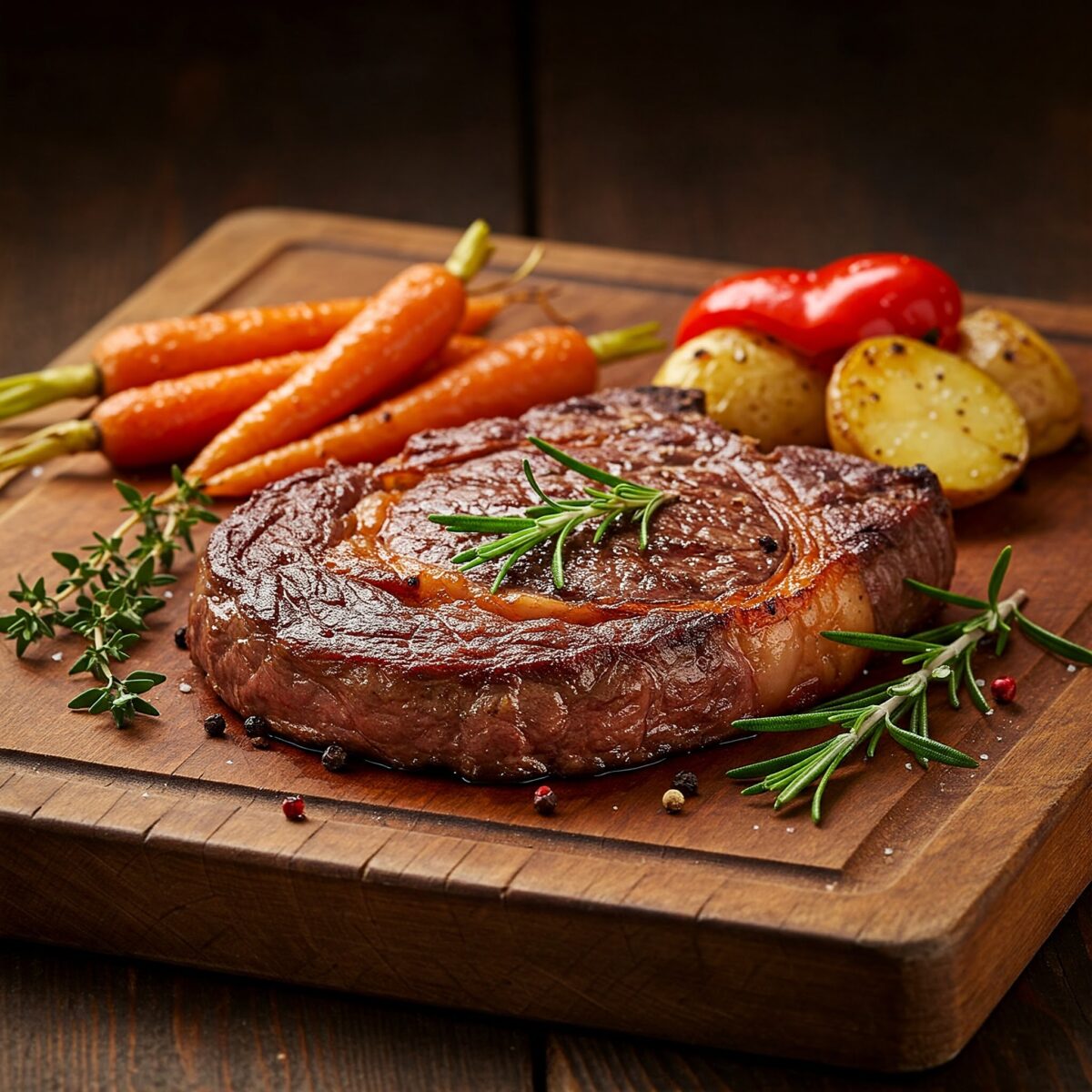The allure of a perfectly cooked steak is undeniable. The sear, the aroma, the tender, juicy interior – it’s a culinary experience that transcends mere sustenance and becomes a moment of pure indulgence. But achieving steak perfection isn’t simply about throwing a cut of meat on a hot pan. It’s a delicate balance of understanding the meat, mastering the cooking process, and appreciating the nuances that elevate a good steak to an unforgettable one. This comprehensive, UK-focused guide will take you on a journey from selecting the ideal cut to plating a masterpiece, ensuring your next steak is the best you’ve ever had.
The Quest for the Perfect Steak: A UK-Focused Guide
The Foundation: Choosing the Right Cut (UK Perspective)
The journey to steak nirvana begins long before you fire up the grill or preheat the oven. It starts with selecting the right cut of meat. The cut dictates not only the flavour profile but also the texture and tenderness of your final product. Here’s a breakdown of some of the most popular and prized cuts for steak available in the UK:
- Ribeye: Often considered the king of steaks, the ribeye boasts rich, intense flavour due to its generous marbling (intramuscular fat). This marbling renders during cooking, basting the steak from within and resulting in a melt-in-your-mouth texture. Ribeyes are best cooked medium-rare to medium to maximise their flavour and tenderness. They can be bone-in (sometimes called a “cowboy steak” or “tomahawk”) or boneless.
- Sirloin: A popular and readily available choice in the UK, the sirloin offers a good balance of flavour and tenderness. It’s a leaner cut than the ribeye but still has enough marbling to provide a satisfying flavour. The sirloin is best cooked medium-rare to medium and holds up well to grilling or pan-searing. A “Topside” or “Silverside” joint can be cut into steaks, but these are leaner and benefit from marinating.
- Fillet Mignon: Known for its unparalleled tenderness, the fillet mignon is a lean cut from the tenderloin. It’s incredibly buttery and has a subtle, delicate flavour. Due to its leanness, the fillet mignon can dry out if overcooked, so it’s best served rare to medium-rare. Its smaller size also makes it ideal for individual portions.
- Porterhouse/T-Bone: These impressive cuts are essentially two steaks in one: a sirloin and a fillet, separated by a T-bone. They offer the best of both worlds – the robust flavour of the sirloin and the tenderness of the fillet. Porterhouses have a larger fillet portion. These are best cooked medium-rare to medium and are ideal for sharing.
- Rump: A more economical choice, the rump is a leaner cut with a strong beefy flavour. It can be a bit chewier than other cuts, but it’s still delicious when cooked properly. Rumps are best cooked medium to medium-well to prevent them from becoming too tough. Often a good choice for those who prefer a leaner steak.
- Hanger Steak/Onglet: Increasingly popular in the UK, this flavourful cut, also known as the “butcher’s cut,” is prized for its rich, beefy taste. It’s best cooked rare to medium-rare and should be sliced against the grain to maximise tenderness.
- Skirt Steak: Another flavourful and affordable option, the skirt steak is a thin cut that’s best marinated and cooked quickly over high heat. It’s perfect for fajitas or stir-fries.
- Flank Steak: Similar to the skirt steak, the flank steak is a lean cut with a strong beefy flavour. It’s best marinated and cooked quickly over high heat and should be sliced against the grain.
Beyond the Cut: Quality and Preparation (UK Focus)
Choosing the right cut is only the first step. The quality of the meat and the preparation before cooking are equally crucial. Look for these factors in the UK market:
- British Beef: Look for beef that is specifically labelled as British. This supports local farmers and often indicates higher welfare standards.
- Grades/Certification: While the USDA grading system isn’t used in the UK, look for quality assurance marks like the Red Tractor, which indicates that the beef has met certain standards for animal welfare, traceability, and food safety.
- Butcher’s Shop vs. Supermarket: While supermarkets offer convenience, butchers often provide expert advice and source their meat from local farms. They can also offer specific cuts and prepare the meat to your liking.
- Dry-Aging: Dry-aged beef is becoming more common in the UK. Ask your butcher if they offer dry-aged cuts. It will be more expensive but offers a richer, more complex taste.
- Marbling: As mentioned earlier, marbling is the intramuscular fat that contributes to flavour and tenderness. Look for cuts with even distribution of marbling throughout.
- Thickness: A thicker steak (at least 1 inch, ideally closer to 1.5-2 inches) is ideal for achieving a perfect sear and a juicy interior. Thinner steaks are more prone to overcooking.
- Temperature: Before cooking, allow your steak to come to room temperature for at least 30 minutes, or up to an hour for thicker cuts. This will ensure even cooking.
- Seasoning: Generously season your steak with salt (ideally sea salt) and freshly ground black pepper at least 30 minutes before cooking, or even overnight. The salt will draw out moisture, which will then dissolve the salt and create a brine, resulting in a more flavourful and tender steak. Don’t be afraid to use a lot of salt – you’ll be surprised how much the steak can handle.
The Art of Cooking: Step-by-Step Guide
Now that you’ve selected and prepared your perfect steak, it’s time to cook it. There are several methods for cooking a steak, each with its own advantages. Here are two of the most popular and effective methods:
1. Pan-Searing:
- Equipment: A heavy-bottomed skillet (cast iron is ideal) is essential for pan-searing. You’ll also need tongs for flipping the steak and a reliable digital meat thermometer.
- Heat: Heat your skillet over high heat until it’s smoking hot. This is crucial for developing a good sear.
- Oil: Add a high-heat oil, such as rapeseed oil (widely available and recommended in the UK) or groundnut oil, to the skillet. Avoid using olive oil, as it has a lower smoke point and can burn.
- Searing: Place the steak in the hot skillet and sear for 2-3 minutes per side, depending on the thickness of the steak and your desired level of doneness. Don’t overcrowd the pan – sear steaks in batches if necessary.
- Finishing: After searing, reduce the heat to medium-low and continue cooking the steak until it reaches your desired internal temperature. Use a meat thermometer to ensure accuracy. You can add a knob of butter to the pan during the last minute of cooking for extra flavour.
- Resting: Once the steak is cooked, remove it from the skillet and let it rest for at least 10 minutes (ideally 15 for thicker cuts) before slicing and serving. This allows the juices to redistribute throughout the steak, resulting in a more tender and flavourful product.
2. Grilling/Barbecuing:
- Equipment: A barbecue with hot coals or a preheated gas grill is essential for grilling. You’ll also need tongs and a digital meat thermometer.
- Heat: Preheat your grill to high heat.
- Oiling: Lightly oil the grill grates to prevent the steak from sticking.
- Grilling: Place the steak on the hot grill and grill for 2-3 minutes per side for rare, 3-4 minutes per side for medium-rare, 4-5 minutes per side for medium, and 5-6 minutes per side for medium-well. Use a meat thermometer to ensure accuracy.
- Resting: Remove the steak from the grill and let it rest for at least 10 minutes (ideally 15 for thicker cuts) before slicing and serving.
Internal Temperature Guide (UK Recommendations):
- Rare: 52-55°C (125-131°F)
- Medium-Rare: 55-60°C (131-140°F)
- Medium: 60-65°C (140-149°F)
- Medium-Well: 65-70°C (149-158°F)
- Well-Done: 70°C+ (158°F+) (Generally not recommended for quality cuts)
Beyond the Basics: Flavour Enhancements
While a perfectly cooked steak seasoned with just salt and pepper is a culinary delight, there are several ways to enhance the flavour and elevate your steak experience.
- Compound Butter: A compound butter is simply butter that has been mixed with herbs, spices, or other flavourings. It’s a fantastic way to add a burst of flavour to your steak. Some popular combinations include garlic-herb butter, chilli butter, or blue cheese butter.
- Sauces: A classic steak sauce, such as a Béarnaise or a chimichurri, can add complexity and depth to your steak. A simple peppercorn sauce is also a classic choice.
- Marinades: Marinades are a great way to tenderise and flavour tougher cuts of meat, such as skirt steak or flank steak. A simple marinade of olive oil, garlic, herbs, and lemon juice can work wonders.
- Dry Rubs: Dry rubs are a blend of herbs and spices that are rubbed onto the steak before cooking. They add a flavourful crust and can be customised to your liking. Smoked paprika, chilli powder, and brown sugar are popular ingredients.
Steak Meal Accompaniments: Completing the Feast (UK Style)
A perfect steak deserves equally delicious accompaniments. Here are three tips on steak meal accompaniments, with a UK twist:
- Classic Comfort: Pair your steak with classic British sides like chips (thick-cut fries), roasted potatoes, Yorkshire puddings, or a simple green salad with a vinaigrette dressing. These sides complement the richness of the steak without overpowering it. Consider adding some seasonal vegetables like asparagus, green beans, or carrots.
- Modern Twists: Explore modern flavour combinations by pairing your steak with sides like creamy leeks, roasted parsnips, or a cauliflower cheese gratin. These add a touch of sophistication to your steak meal.
- Wine Pairing (UK Preferences): Wine and steak are a match made in heaven. A bold Cabernet Sauvignon or a rich Merlot pairs beautifully with a ribeye or a sirloin. A lighter Pinot Noir complements a fillet mignon. Consider also a Malbec, which is increasingly popular in the UK. Don’t forget about other beverages as well. A good quality real ale, a craft lager, or even a refreshing gin and tonic can enhance the steak-eating experience.
Conclusion: The Pursuit of Steak Perfection (UK Edition)
Cooking the perfect steak is a journey of discovery. It’s about understanding the nuances of different cuts readily available in the UK, mastering the cooking process, and appreciating the subtle flavours that make each steak unique. While there’s no single “right” way to cook a steak, by following the guidelines in this article and experimenting with different techniques and flavour combinations, you can embark on your own quest for steak perfection and create unforgettable culinary experiences. So, fire up the barbecue, grab your favourite cut of British beef, and get ready to indulge in the ultimate steak feast!
Get help to protect and grow your business faster
Find out more about Lifestyle Improvement Club Corporate Membership
Subscribe for free lifestyle improvement tips reviews and money saving ideas to improve your life in UK
Read more lifestyle improvement articles and view videos
Read view learn more :
- How to cook a perfect ribeye steak at home uk pan fry
- Best way to cook british sirloin steak medium rare bbq recipe
- Tenderise rump steak before cooking uk tips and tricks
- Dry aged fillet steak recipe pan sear with butter uk guide
- Best sides for steak dinner uk roast potatoes yorkshire pudding
Relevant hashtags :
- #SteakNightUK
- #BritishBeef
- #PerfectSteak
- #HomeCookingUK
- #SteakTips
Steak Night UK



